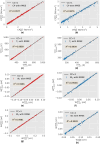A novel machine learning workflow to optimize cooling devices grounded in solid-state physics
- PMID: 39558085
- PMCID: PMC11574113
- DOI: 10.1038/s41598-024-80212-9
A novel machine learning workflow to optimize cooling devices grounded in solid-state physics
Abstract
Cooling devices grounded in solid-state physics are promising candidates for integrated-chip nanocooling applications. These devices are modeled by coupling the quantum non-equilibirum Green's function for electrons with the heat equation (NEGF+H), which allows to accurately describe the energetic and thermal properties. We propose a novel machine learning (ML) workflow to accelerate the design optimization process of these cooling devices, alleviating the high computational demands of NEGF+H. This methodology, trained with NEGF+H data, obtains the optimum heterostructure designs that provide the best trade-off between the cooling power of the lattice (CP) and the electron temperature ([Formula: see text]). Using a vast search space of [Formula: see text] different device configurations, we obtained a set of optimum devices with prediction relative errors lower than [Formula: see text] for CP and [Formula: see text] for Te. The ML workflow reduces the computational resources needed, from two days for a single NEGF+H simulation to 10 s to find the optimum designs.
© 2024. The Author(s).
Conflict of interest statement
Figures







Similar articles
-
Quantum Transport in a Silicon Nanowire FET Transistor: Hot Electrons and Local Power Dissipation.Materials (Basel). 2020 Jul 26;13(15):3326. doi: 10.3390/ma13153326. Materials (Basel). 2020. PMID: 32722649 Free PMC article. Review.
-
Collisionless cooling of perpendicular electron temperature in the thermal quench of a magnetized plasma.Sci Rep. 2024 Oct 8;14(1):23448. doi: 10.1038/s41598-024-73968-7. Sci Rep. 2024. PMID: 39379433 Free PMC article.
-
Thermionic cooling devices based on resonant-tunneling AlGaAs/GaAs heterostructure.J Phys Condens Matter. 2018 Feb 14;30(6):064005. doi: 10.1088/1361-648X/aaa4cf. J Phys Condens Matter. 2018. PMID: 29297468
-
First-principles based simulations of electronic transmission in ReS2/WSe2 and ReS2/MoSe2 type-II vdW heterointerfaces.Sci Rep. 2021 Dec 6;11(1):23455. doi: 10.1038/s41598-021-02704-2. Sci Rep. 2021. PMID: 34873179 Free PMC article.
-
Nonequilibrium Green's function method for phonon heat transport in quantum system.J Phys Condens Matter. 2022 Mar 31;34(22). doi: 10.1088/1361-648X/ac5c21. J Phys Condens Matter. 2022. PMID: 35263716 Review.
References
-
- Gaska, R., Osinsky, A., Yang, J. & Shur, M. Self-heating in high-power AlGaN-GaN HFETs. IEEE Electron. Device Lett.19, 89–91. 10.1109/55.661174 (1998).
-
- Pop, E. & Goodson, K. E. Thermal phenomena in nanoscale transistors. J. Electron. Packag.128, 102–108. 10.1115/1.2188950 (2006).
-
- Bar-Cohen, A. & Wang, P. On-chip thermal management and hot-spot remediation 349–429 (Springer, 2009).
-
- Gong, T. et al. Co-optimization of electrical-thermal-mechanical behaviors of an on-chip thermoelectric cooling system using response surface method. Appl. Therm. Eng.244, 122699. 10.1016/j.applthermaleng.2024.122699 (2024).
-
- van Erp, R., Soleimanzadeh, R., Nela, L., Kampitsis, G. & Matioli, E. Co-designing electronics with microfluidics for more sustainable cooling. Nature585, 211–216. 10.1038/s41586-020-2666-1 (2020). - PubMed
Grants and funding
LinkOut - more resources
Full Text Sources
Miscellaneous

